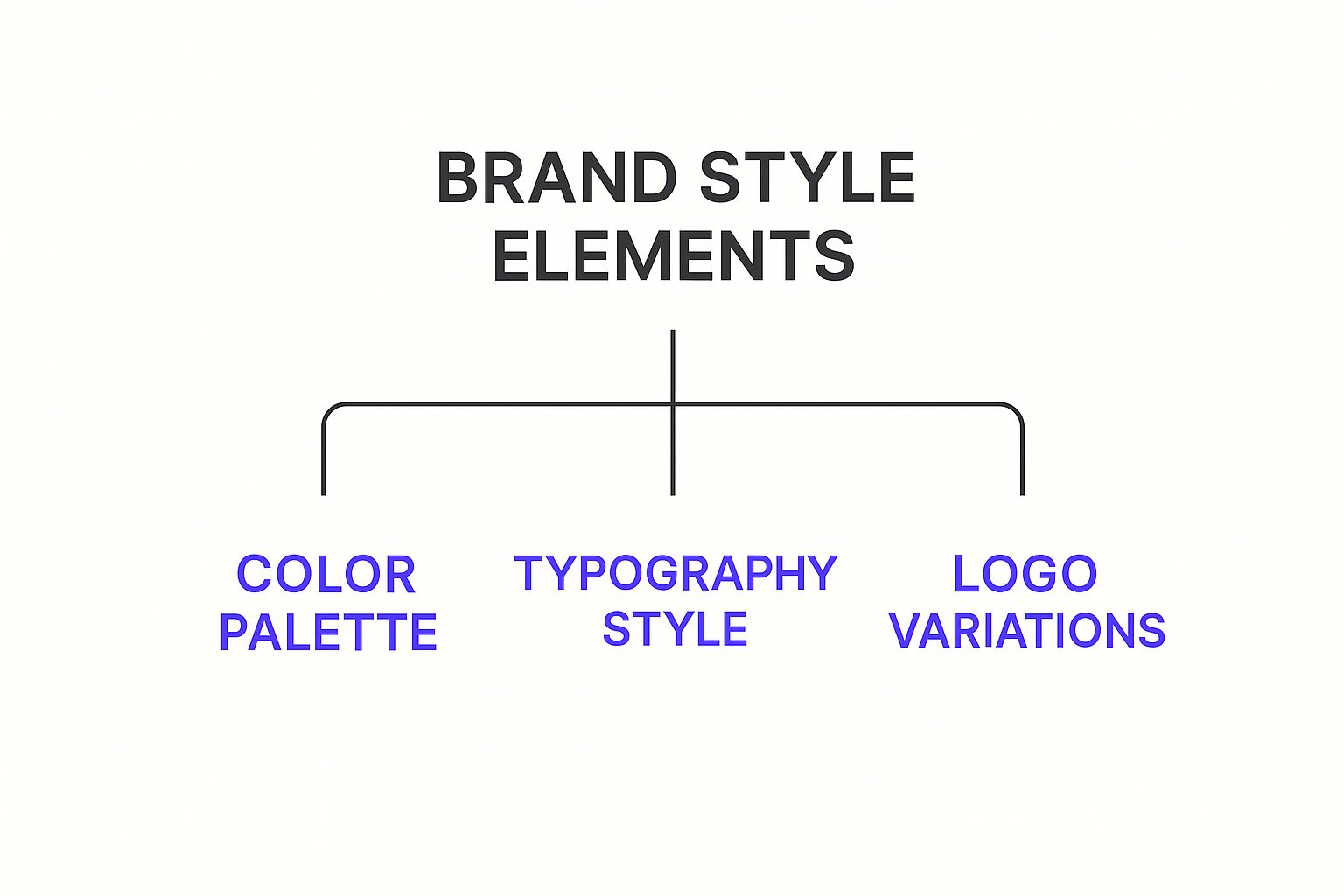A solid social media branding guide is your roadmap. It helps you pin down your brand’s identity, define its voice, and lock in a visual style. When you have this in place, every single post, comment, and campaign works together to build a strong, recognizable, and trusted presence online.
Why Social Media Branding Matters Now More Than Ever
Let's be real: social media isn't just another marketing channel anymore. It’s the main stage where modern brands are built and where reputations are made or broken. Platforms like Instagram, TikTok, and LinkedIn aren't just simple networks; they've become bustling digital towns where your audience forms its first—and most lasting—impression of who you are.
Think of it this way: your social media profile is your digital handshake, your storefront, and your community hall all rolled into one. A strong, consistent brand here doesn't just pull in followers. It builds trust, creates loyalty, and has a direct impact on how customers see you. Getting this right isn't just a good idea; it's essential for any kind of sustainable growth.
The Shift from Megaphone to Community Hub
Not long ago, brands treated social media like a megaphone for shouting ads. Today, that approach just doesn't work. Your audience is looking for genuine connection and authenticity. Great social media branding turns your profile from a billboard into a destination—a place where people feel seen, understood, and valued.
This shift is so important because a strong brand makes your business feel human. It gives you a personality that people can actually connect with, forging an emotional bond that goes way beyond a one-time purchase. For e-commerce businesses, this is a massive advantage. You can dig deeper into this in our detailed guide to ecommerce social media marketing.
The scale of this change is staggering. By 2025, social media became a non-negotiable strategy for businesses everywhere, a trend fueled by explosive growth. Global social media ad spend shot up from $19.8 billion in 2015 to an incredible $270–$277 billion in 2025. This massive jump is tied directly to user growth, with active users climbing from 2.1 billion to over 5.3 billion in the same timeframe—that's nearly 64% of the world's population. To get a better sense of this incredible expansion, you can explore the full social media statistics for 2025.
A brand is no longer what we tell the consumer it is—it is what consumers tell each other it is. This makes every interaction on social media a critical branding opportunity.
Building Tangible Business Value
Consistent social media branding delivers real, concrete results that hit your bottom line. This isn't just about looking good online; it's about building an asset that drives revenue and locks in your position in the market.
Here’s a quick look at how a focused strategy pays off:
- Increased Recognition: A cohesive look and consistent voice make your brand instantly recognizable, even in a fast-scrolling feed.
- Enhanced Customer Loyalty: When customers connect with your brand's values, they’re far more likely to stick around as repeat buyers and even become advocates.
- Improved Trust and Credibility: Professionalism and consistency send a clear signal: your business is reliable and trustworthy.
To truly get the full picture of how social media branding works, it helps to see how it fits into the broader goal of getting noticed. Take a look at these 9 Essential Brand Awareness Strategies to see how these ideas play into a larger marketing plan.
Defining Your Brand’s True Identity
 Before you even think about crafting that killer social media post, we need to hit pause and ask a much bigger question: who is your brand, really? A rock-solid brand identity is the bedrock of everything we're going to talk about. It’s so much more than a logo or a catchy tagline; it's the core personality that makes people recognize, trust, and stick with you.
Before you even think about crafting that killer social media post, we need to hit pause and ask a much bigger question: who is your brand, really? A rock-solid brand identity is the bedrock of everything we're going to talk about. It’s so much more than a logo or a catchy tagline; it's the core personality that makes people recognize, trust, and stick with you.
Think of it like developing a character for a movie. That character has clear motivations, a set of beliefs, and a unique perspective. Without that foundation, your social media feels random and, frankly, forgettable. Get it right, and every post becomes another page in a story your audience genuinely wants to follow.
The Three Pillars of Brand Identity
To build this foundation, you need to define three non-negotiable components. These pillars will be your North Star, guiding every single social media decision you make. Trying to build a brand without them is like setting sail without a map—you'll be busy, but you'll have no idea where you're headed.
- Your Mission: This is your "why." Forget about profits for a second—what problem do you exist to solve? What change do you want to bring to your corner of the world?
- Your Core Values: These are the principles you'd stick to no matter what. Are you all about innovation, community, sustainability, or maybe just no-nonsense honesty? Nail down three to five core values that act as your brand's code of conduct.
- Your Unique Value Proposition (UVP): This is what makes you the only choice for your ideal customer. In a crowded market, what promise can you make that no one else can? This is your secret sauce.
These elements aren't just corporate fluff; they create a powerful framework that keeps you consistent as you grow. And consistency breeds trust. In fact, research shows a whopping 88% of consumers say authenticity is key when deciding which brands to support. This internal clarity is your first step toward being authentic.
Go Beyond Demographics to Build Audience Personas
Okay, so you know who you are. But who are you talking to? A fuzzy idea of your "target market" just won't cut it anymore. You need to create detailed audience personas—think of them as semi-fictional character sheets for your ideal customers, built from real data and a bit of educated guesswork.
An audience persona moves beyond simple data points like age and location. It gives your audience a name, a face, and a story, making it infinitely easier to create content that speaks directly to their needs and desires.
Instead of just looking at the numbers, you have to understand the human on the other side of the screen. This is the secret to crafting content that truly connects.
Building a Useful Persona
To create a persona that actually helps you, try to answer these questions:
- Goals and Motivations: What are they trying to accomplish? What gets them out of bed in the morning?
- Pain Points and Challenges: What's getting in their way? What frustrations can your brand help eliminate?
- Online Habits: Where do they spend their screen time? Are they hooked on quick TikToks, in-depth articles, tutorials, or behind-the-scenes Stories?
- Watering Holes: Where do they really hang out online? Are they active in specific Facebook groups, subreddits, or following certain influencers?
By answering these, a faceless "user" suddenly becomes "Creative Chloe," a 28-year-old freelance designer struggling to manage clients and hunting for inspiration on Pinterest and Instagram. Now you know exactly who you're talking to, making your social media efforts sharper, smarter, and far more effective.
Crafting Your Unforgettable Brand Voice and Visuals
Alright, let's get down to business. We've talked about the "why" behind your brand—your mission and values. Now it's time to craft the "what"—the tangible, real-world elements your audience will actually see and interact with every single day. This is where your brand gets its face and its voice.
Think of it this way: your visual identity is your brand's wardrobe, and your brand voice is how it talks. Just like a person, you need both to be consistent to build trust. You wouldn't trust someone who completely changes their personality and style every time you meet them, right? The same goes for your brand.
Defining Your Visual Signature
Your visual identity is so much more than a logo. It's a complete system of design elements that work together to create an instant feeling and recognition. When you nail this, your visuals can stop someone mid-scroll simply because they feel like you.
This diagram perfectly shows how all the core components of your visual style flow from your central strategy.

As you can see, your logo doesn't work in a vacuum. It's backed by carefully chosen colors and fonts that amplify its message. Let's break down these key pieces.
- Color Palette: Colors are emotional shortcuts. A palette of blues and grays can feel professional and trustworthy, while bright yellows and pinks shout energy and fun. Pick 3-5 primary and secondary colors that match your brand's personality and stick to them.
- Typography: The fonts you choose say a lot. A classic serif font might suggest tradition and authority, whereas a clean sans-serif font feels modern and approachable. Beyond just colors and logos, mastering design in typography is a game-changer for creating visuals that truly reinforce your brand.
- Imagery Style: What do your photos and videos look like? Are they polished and professional, or are they more candid and behind-the-scenes? Decide on a consistent style for lighting, composition, and subject matter to build a cohesive, recognizable feed.
Finding Your Authentic Brand Voice
If visuals are what people see, your brand voice is what they hear. It's the unique personality that shines through in your captions, comments, and DMs. A strong voice makes your brand feel like a real character, not a faceless corporation.
To figure this out, start by thinking in archetypes. Is your brand "The Jester," always ready with a witty comeback? Or maybe "The Sage," focused on delivering deep, educational insights? Choosing an archetype gives you and your team a clear North Star for all communication.
A well-defined voice is a non-negotiable part of any solid social media content strategy because it ties everything together, making a simple Tweet and a detailed blog post feel like they came from the same place.
The Brand Voice Archetypes and Their Social Media Application Table
To make this more concrete, this table breaks down how different brand archetypes show up on social media. It's a great starting point for finding the voice that feels right for you.
| Archetype | Core Desire | Social Media Tone | Example Language |
|---|---|---|---|
| The Innocent | To be happy | Optimistic, simple, genuine | "We believe in the good stuff." "Here's to a brighter day!" |
| The Sage | To find the truth | Wise, knowledgeable, factual | "Studies show that..." "Let's explore the data behind this." |
| The Explorer | Freedom to discover | Adventurous, daring, independent | "Break free from the ordinary." "What's over the next horizon?" |
| The Jester | To live in the moment | Playful, humorous, witty | "Don't take life too seriously." "Because adulting is hard." |
| The Lover | Intimacy and experience | Passionate, sensual, appreciative | "Indulge your senses." "Crafted with passion, just for you." |
| The Hero | To prove one's worth | Brave, confident, inspirational | "Challenge the status quo." "Be the change you want to see." |
Use these archetypes as a launchpad. You can even blend elements from a couple to create something uniquely your own. The goal is to find a voice that's not only authentic to your brand but also resonates with the people you want to reach.
Developing a Content Strategy That Connects

If your brand identity is a high-performance engine, then your content strategy is the GPS. It’s powerful, sure, but without a clear road map, you’re just spinning your wheels. This is where you translate your brand's values into real posts, videos, and stories that actually connect with people.
The biggest mistake I see brands make? A one-size-fits-all approach. Your content needs to be just as unique as your brand voice. We're moving from who you are to what you'll talk about, making sure every single piece of content serves a purpose and gives your audience something valuable.
Establish Your Core Content Pillars
Forget about random brainstorming sessions that lead nowhere. You need to build your strategy on content pillars. Think of these as the three to five core topics your brand can speak on with real authority. These pillars are the bedrock of your content calendar, born right at the intersection of your expertise and your audience's interests.
Content pillars are what keep your feed from feeling like a scattered mess of unrelated posts. They keep you focused and consistent, proving over and over that you're an expert in the areas your followers actually care about.
To figure out your pillars, just ask yourself these questions:
- What topics are a perfect match for our brand’s mission and values?
- What are the biggest questions or pain points our target audience has?
- What unique angle or insight can we offer that nobody else is?
A sustainable fashion brand, for instance, might land on pillars like "Ethical Production," "Styling Timeless Pieces," and "Behind the Seams." This framework gives them the freedom to create a variety of content that always ties back to what they stand for.
Master the Art of Repurposing Content
Let’s be real: creating great content takes a lot of work. So why not make every idea work harder for you? That's where smart repurposing comes in. The idea is to take one big, juicy piece of content and slice it up into multiple formats for all your different social channels.
This isn’t just about saving time; it’s about reinforcing your message everywhere your audience hangs out. A single deep-dive blog post can become a dozen different social media assets, each one perfectly tweaked for the platform it’s on. This is strategic adaptation, not just copy-pasting.
Repurposing content isn't about being lazy; it's about being efficient. It ensures your best ideas reach the widest possible audience in the format they prefer, maximizing your creative investment.
Here’s what that looks like in action:
- Start with a "Hero" Piece: Kick things off with something substantial, like a detailed blog post, a long-form video, or a comprehensive case study.
- Break It Down: Pull out the best quotes, key stats, and actionable takeaways.
- Adapt for Each Platform: Now, transform those pieces. That takeaway becomes a slick carousel for Instagram. That quote becomes part of a thought-provoking thread on X. The core concept becomes a quick-tip video for Reels or TikTok, and the whole thing can be summarized for a professional article on LinkedIn.
Meeting your audience on multiple platforms is a must. The average social media user will be on 6.83 different social networks a month by 2025. And with 78% of people saying they prefer learning about products through short videos, you can't afford to ignore video. You can explore more social media statistics to see just how vital a multi-format strategy really is.
Prioritize Value Over Virality
At the end of the day, your goal is to build a loyal community, not just chase a viral hit. A viral post is a great sugar rush, but a steady stream of genuinely valuable content is what builds trust and keeps people coming back.
Every post should do one of three things for your audience:
- Educate: Teach them a new skill, solve a nagging problem, or offer a fresh perspective.
- Entertain: Make them laugh, spark their curiosity, or just give them a moment of joy in their feed.
- Inspire: Motivate them with a success story, show them what’s possible, or champion a cause.
When you consistently deliver this kind of value, the dynamic shifts. You're no longer just a brand trying to sell something; you become a trusted resource they welcome into their daily scroll. That’s how you build a community that sticks around for the long haul.
Using Analytics and AI to Sharpen Your Strategy
 This is where we move from guessing to knowing. A powerful social media brand isn't just built on great content; it’s proven by data that shows what’s actually connecting with people. Analytics and AI are the tools that give you a serious competitive edge, turning a flood of raw data into smart, actionable decisions.
This is where we move from guessing to knowing. A powerful social media brand isn't just built on great content; it’s proven by data that shows what’s actually connecting with people. Analytics and AI are the tools that give you a serious competitive edge, turning a flood of raw data into smart, actionable decisions.
Think of social media analytics as your brand’s personal report card. It tells you exactly how your content is performing, who it's reaching, and how they’re reacting. This goes way beyond vanity metrics like follower counts—it’s about digging into the deep engagement that signals a healthy, growing brand community.
Listening to the Digital Conversation
Beyond your own page, a constant conversation is happening about your brand, your competitors, and your industry. Social listening is the art of tuning into these conversations. It’s like having digital ears all over the internet, giving you a real-time pulse on public sentiment.
With social listening, you can keep track of:
- Brand Mentions: See who’s talking about you, even when they don’t tag your official handle.
- Competitor Activity: Keep an eye on what your rivals are doing, see what’s working for them, and spot the opportunities they’re missing.
- Industry Trends: Identify emerging topics and keywords that your audience cares about, so you can create relevant content before it’s old news.
This constant feedback loop is what keeps you agile. Instead of reacting to trends weeks later, you can adapt your strategy on the fly and make sure your brand is always part of the current conversation.
Using AI as Your Creative Partner
Artificial intelligence isn't some far-off concept anymore; it's a practical tool that can become your new creative partner. Generative AI can help you smash through creative blocks, scale your content production, and streamline your entire workflow. This frees up your team to focus on the big-picture strategy.
For instance, AI can help you:
- Draft Initial Posts: Get multiple caption ideas for a single image, each tweaked for a different platform’s tone and style.
- Brainstorm Content Ideas: Find new angles for your core content pillars or suggest trending topics your audience will love.
- Create Visual Elements: Get help generating simple graphics or suggesting visual concepts for your next campaign.
The real power of AI in social media branding isn’t about replacing human creativity; it’s about augmenting it. It handles the heavy lifting of ideation and drafting, so you can focus on the strategic refinement that makes a brand feel authentic and human.
The impact of these tools is undeniable. Social listening and AI are fundamentally changing how brands operate in 2025. Teams using social listening tools are nearly twice as confident in their marketing ROI. Even better, 90% of businesses using generative AI have seen major time savings, and 73% have recorded real boosts in engagement from their AI-assisted content.
All this data needs to make sense. Turning raw numbers into clear insights is what separates good brands from great ones, which is why a structured approach is a must. For a practical framework, check out our guide on creating a comprehensive social media analytics report template. It’ll help you organize the numbers and present your findings in a way that truly drives your strategy forward.
Your Social Media Branding Action Plan
Alright, let's roll up our sleeves and put all this theory into practice. This is where the magic happens—turning those big branding concepts into a concrete, step-by-step plan you can start using today.
Think of the next part as your launch checklist, whether you're building a social presence from scratch or giving a tired one a much-needed refresh. Following a clear plan is the secret sauce for building a brand that feels consistent and, most importantly, real. Each step logically builds on the one before it, making sure you don’t miss a thing.
Your Core Branding Checklist
This isn't just a random list of tasks; it's a structured flow designed to build your social media presence on a rock-solid foundation. Move through these steps, and you'll be set up for genuine growth and engagement.
1. Define Your Brand Identity: Before you do anything else, get crystal clear on your mission, core values, and what makes you different. This is your brand's North Star. If you can't confidently answer the question, "Who are we, and why should anyone care?" then pause and figure that out first.
2. Create Your Visual and Voice Style Guide: To keep everything consistent, you absolutely need a brand style guide. This is non-negotiable. You can use a detailed step-by-step guide on creating brand guidelines to lock down your colors, fonts, tone of voice, and even how you use emojis.
A complete style guide is an incredible tool. It empowers your whole team to create perfectly on-brand content without needing constant hand-holding. It’s your single source of truth for everything creative.
3. Choose Your Core Platforms: Don't fall into the trap of trying to be everywhere at once. It's a recipe for burnout. Based on your audience research, pick the 2-3 platforms where your ideal customers actually hang out. Quality over quantity always wins.
4. Establish Your Content Pillars: Decide on the 3-5 core topics or themes your brand will consistently talk about. These pillars give your content calendar structure and make sure you’re always delivering something valuable to your audience, not just posting for the sake of it.
5. Set Up Your Analytics: You can't improve what you don't measure. Get your analytics tools set up from day one. Create a simple dashboard to track the metrics that truly matter. Success isn't just about posting; it's about understanding what resonates with your audience and doing more of that.
With this action plan in hand, you're not just informed—you're ready. You have a clear path to follow for building a social media brand that is powerful, consistent, and genuinely connects with people.
Got Questions About Social Media Branding? We've Got Answers.
Even with a solid guide in hand, some questions always pop up when you're getting down to business. Let's tackle some of the most common hurdles people face with social media branding so you can move forward with confidence.
How Often Should I Actually Post?
This is the million-dollar question, but there’s no single magic number. The right posting frequency really depends on the platform's vibe and what your audience expects.
On fast-moving platforms like X (formerly Twitter) or Instagram Stories, daily activity often pays off. But for a professional network like LinkedIn or a community-focused space like Facebook, posting a solid 3-5 times a week can be more than enough to stay relevant.
Here’s the real secret: consistency beats quantity every time. It's far better to share three amazing, on-brand posts each week than to scramble and push out seven forgettable ones. Dive into your analytics to see when your followers are most active and keep an eye on your engagement rates. That data will tell you the perfect rhythm for your brand.
What’s the Real Difference Between Branding and Marketing?
It's easy to get these two tangled up, but they have very different jobs. Think of it like this: your branding is the house you build, and your marketing is the party you throw to invite people over.
- Branding is the foundational work. It's about defining who you are—your personality, your values, your look and feel. It’s the slow, steady work of building a recognizable and trustworthy presence.
- Marketing is the action you take to hit specific goals. These are the campaigns you run—to get leads, drive sales, or grow your email list—using the brand identity you've already built.
A strong brand makes your marketing infinitely more powerful because people already have a sense of who you are and what you stand for. Marketing without branding is just noise. Branding without marketing is like building a fantastic shop on a street no one ever walks down.
How Do I Handle Negative Comments or a Crisis?
The golden rule here is to act fast, stay calm, and be transparent. The best defense is a good offense, which means having a crisis plan ready before you ever need it.
For the occasional negative comment, always acknowledge their point publicly. A simple, "Thanks for bringing this to our attention, we've sent you a DM to sort this out," works wonders. This shows everyone else you're on top of things without turning a small issue into a public spectacle. Then, you take the conversation private to resolve it.
If a bigger crisis hits, your first move is to pause all scheduled posts. Immediately. Get your team together to understand the facts, then issue a clear, honest statement that owns the situation. Whatever you do, don't delete negative comments (unless they're spam or contain hate speech). A calm, human, and responsible response can actually turn a disaster into a moment that reinforces your brand's integrity.
Ready to stop juggling a dozen tabs and start building a brand that feels truly cohesive? PostSyncer brings your content creation, scheduling, and analytics together in one smart, streamlined dashboard. Get your workflow in order and make sure every single post is perfectly on-brand. Start your free trial at PostSyncer.com and see the difference.















